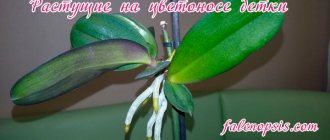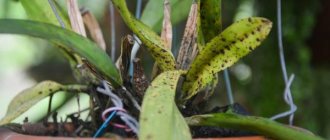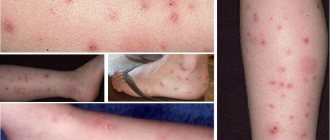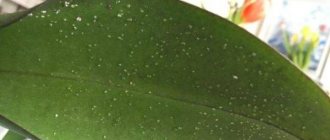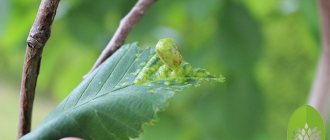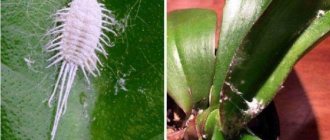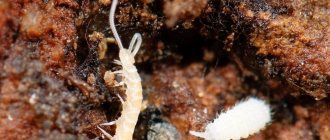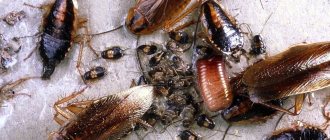Today I will share with you all the secrets of saving orchids from diseases and teach you how to solve some of the problems that arise when caring for orchids . Despite their delicate and fragile appearance, orchids are incredibly hardy. You can almost always save an orchid
Out of ignorance, many breeders make mistakes. Sometimes the joy of expecting something beautiful gives way to disappointment. The reason for this may be withered leaves and buds , lack of flowering , spots on leaves and flowers , as well as more serious orchid diseases .
Agree, the orchid is an incredibly beautiful flower that came to us from Asia. Every flower lover most often purchases several of these wonderful plants. Their beauty and alluring aroma are simply mesmerizing and, having brought this beauty into the house, we begin to carefully care for it.
Orchid does not bloom
Of course, having acquired such beauty, I really want the orchid to bloom as often as possible, but sometimes such disappointment occurs as a long absence of flowering.
This problem can occur for several reasons:
- The first is when you just can’t find a place for it, and you keep carrying it around the house looking for something better, waiting for it to bloom. In fact, by doing this you only slow down the release of the peduncle of the orchid. When moved to a new place, it begins to adapt again and all its energy goes towards this, and not towards flowering. Find her one permanent place for the entire rest period.
- Lighting plays a very important role in flowering. There should be a lot of light, but of course not direct sunlight. If it has very little light or, on the contrary, too much light, it will not bloom for a long time. Place it close to the window, but so that the sun does not shine on it.
- Poor root system. If there is no flowering for a long time, then there is a reason to remove it from the pot and examine the root system. Perhaps root rot has appeared or, on the contrary, the roots are drying out. Then it’s worth starting to resuscitate the plant. You will learn further by reading this article about how to save an orchid with problems with roots and what problems you may still encounter.
Prevention measures
To prevent an epidemic, the affected plant is isolated from others. The window it was on is easy to clean. The old soil is thrown away. The pots are washed and disinfected with a chlorine-containing cleaner.
Prevention measures:
- Temperature control inside the substrate. The plant should not be cooled to low temperatures or overheated.
- Proper watering. Excessive moisture is an excellent environment for the development of pathogens.
- Control of soil composition. Avoid too high foam or peat content. The substrate changes acidity and expels beneficial microorganisms. The share of synthetics and peat is 10-20% of the total volume of components.
- Proper feeding. Excess nitrogen and iron lead to soil salinity, weakening the flower’s immunity.
Compliance with these simple conditions will allow you to grow a beautiful, spectacular plant at home. It is only important to pay attention to the subtleties of caring for the crop and take the necessary measures in time.
Orchid buds wither and dry out
Having brought the orchid into the house after a few days, everyone notices that such beautiful and desirable buds began to wither, and then dry out and fall off. All of them, of course, never fall off, but the other pair always withers and dries up. Many people start to panic and it seems to them that the plant is spoiled or sick, or maybe it urgently needs to be watered or put in the sun, or maybe removed. All this panic is completely unnecessary.
Substrate for orchids
Your orchid is simply adapting. She has come a long way to you from Asia or came from a special greenhouse. But, one way or another, the orchid lived in completely different conditions, where there was an ideal climate, temperature and humidity - they were ideal for it. It’s like sending a resident of Siberia to live in Africa with year-round heat. The same thing happens with the orchid. It simply begins to adapt, and so that the entire plant as a whole does not suffer damage, the orchid gets rid of several buds so as not to waste on them the valuable nutrients that are needed for adaptation. When the orchid is fully adapted, it will no longer shed buds.
But if an orchid has been living in your house for a long time, and suddenly the buds begin to fall off, then you should start looking for the reason for this behavior of the plant. Perhaps it has acquired a neighbor in the form of parasites or, again, the root system is not in order.
Plant treatment
Depending on why the white spots appear, treatment will vary . The most important thing in this is to correctly understand the cause and eliminate it.
Help with waterlogging
If the reason for the change in the appearance of the leaf plate is waterlogging, it will not be possible to return the leaf to its previous healthy appearance . To improve the aesthetic effect, it will only be possible to completely remove it with a sharp knife, sprinkling the cut area with crushed coal.
How to eliminate burn damage on leaves?
If the leaf is affected, spots appear on it - there is practically no chance of returning it to a healthy appearance . Burn marks on them are irreversible, so it is worth eliminating the cause of the changes and from now on being more attentive to the flower.
Caring for a plant when it dries out
White spots that appear as a result of the plant's root system drying out or staying in a room with dry air for a long time cannot disappear after watering or changing the conditions for the better .
Normalizing the plant's conditions will help prevent this problem from reoccurring on new leaves.
How to eliminate the consequences of fungal infection?
Elimination of the consequences of orchid infection by fungus should proceed as follows:
- Removing the affected organ of the plant so that the infection does not spread to other parts of the orchid;
- Air humidity regulation
- Constantly ventilate the room in which the plant is located. Orchids respond very well to a constant flow of fresh air;
- The use of immuno-strengthening drugs (Epin, Zircon), which will help the flower recover faster;
- Careful regular visual inspection to avoid relapse.
White sunken spots - what are they and how are they treated?
Such spots can appear as a result of an improper watering system - most often, this happens when watering too often and abundantly and using hard water. This problem is easy to solve - you need to adjust the amount and frequency of watering .
The appearance of spots on orchid flowers
Spots on orchid flowers rarely appear due to disease; the main reason for their appearance is mechanical damage. They usually dry out and the edges of these spots are always uneven.
Spots on orchid petals
They may appear during transportation if condensation has occurred inside the package and the flowers were in very high humidity.
Also, such spots appear due to the fact that the flower was in the sun and there were drops of water on the flowers. In this case, the drop acts as a water lens and the flower receives a burn, which you see on the flower in the form of spots.
Quite rarely, but still not excluded, this is a fungal infection of the plant. In this case, spots appear very quickly. Within just one day, all the flowers can become covered with spots. Next, the entire plant will be affected by the fungus, the stems and foliage will become watery and mold will quickly appear on them. In this case, it is urgent to treat the entire plant with an antifungal agent, which can be purchased at any specialty store. Also, such a plant must be placed separately from the rest, otherwise all the plants nearby, especially orchids, will be infected.
Chlorosis in the photo
Yellowing plant leaves may be a result of chlorosis infection. The disease is divided into infectious and non-infectious.
Infectious chlorosis is accompanied by the appearance of spots and tubercles. The cause of infection can be viruses, bacteria, fungi or parasites. Treated with antifungal drugs.
A non-infectious disease occurs due to micronutrient deficiency or poor lighting. In this case, it is necessary to create comfortable conditions for the flower and add fertilizer to the soil.
Rot on orchids
Rot is one of the most terrible enemies of the orchid, which has killed quite a few representatives of this beautiful plant. It comes in several types. Now we will look at each type of rot separately and learn how to save our beauties from it.
Brown rot
It is simply impossible not to notice brown rot It appears on the leaves. This is a watery, brown spot on a leaf. If you allow it to grow and develop, the entire plant will eventually rot. Brown rot appears if you water the orchid incorrectly, or if you start spraying it generously. Then water will get into the base of the leaf, and it will begin to rot.
Of course, you can save the plant, but only if you start fighting immediately. But if the rot develops severely, then, alas, the orchid will be lost. In order to get rid of it, you need to take a sharp instrument: a knife or something like a scalpel, and treat it with alcohol. Then cut away all the rot, taking some healthy tissue. The cut areas must be sprinkled with crushed activated carbon or ground cinnamon.
Root rot
Root rot is one of the most common causes of death of orchids. It affects the roots.
If you do not notice it in time, then very quickly the rot will destroy the entire root system of the orchid. It occurs due to flooding of the plant. If there is too much moisture, rot will occur immediately. It is quite possible to save the plant, if, of course, resuscitation is started in time.
First you need to remove the orchid from the pot. Shake off all the soil. Then it is necessary to remove the outer shell, which has rotted, from the rotten roots. The root sheath is called the velomen and surrounds the central shaft. Clean your hands with alcohol and carefully pull off all the rotten bicycle leather from the shaft. Usually the rod remains intact, but if the rod has rotted, then cut this root with scissors treated with alcohol.
1) This is what root rot looks like in a pot. 2) Orchid root rot. 3) Velomen. 4) Orchid roots after removing the veloman
Then, when you have removed all the rot, treat all the roots with activated charcoal powder or ground cinnamon.
Then plant the orchid in a new pot and orchid substrate. Place the orchid pot in partial shade and do not water for 3-4 days.
Then take 1 tablet of succinic acid and dissolve it in 1 liter of boiled water. Buy the orchid in this solution a little. Also moisten a cotton pad with it and wipe the leaves. Afterwards, do not bathe her for 10-14 days, or even longer if there is still moisture in the bark (substrate).
Gray rot
It is simply not possible to miss this type of rot. Initially, it appears on the leaves of the orchid and looks like a gray spot with a fluffy coating. If left untreated, it will very quickly spread to the ground, and then attack the entire plant.
This rot occurs when the humidity is very high, but the room temperature is low.
As soon as you see the appearance of gray rot , immediately cut off all areas of rot. Change the substrate and treat the entire plant with fungicides. If after this rot occurs again, then your drug is not effective and it must be changed to another.
Be sure to separate the diseased plant from healthy ones.
Orchids with white flowers are most susceptible to gray rot.
Black rot
Black rot on an orchid
Black rot is very easy to recognize, because it is black. Basically, it appears when the plant is too cold, much less often the cause is insect pests.
To combat it, it is necessary to cut off all affected areas with a sharp, sterile object. Sections should be treated with wood ash powder or a solution of Bordeaux mixture.
It is also necessary to transplant the orchid into a new substrate and not water or moisten it for three days.
Fusarium rot
When affected by this type of rot, the foliage becomes soft, it begins to curl and acquires first a yellow and then a pinkish tint.
This disease is caused by high indoor humidity and lack of air ventilation.
It is quite possible to save the plant; you must again remove the affected areas with a sharp, sterile object. Then it is necessary to treat with a solution of “Fundazol” three times in 1 day. Naturally, transplantation into a new substrate is necessary. Place the plant in a drier area.
How to cure?
Treatment of the plant should be started immediately after the first symptoms are detected and the flower is examined.
Chemicals
Chemicals are an essential component of any orchid treatment.
In the garden store you can find many effective remedies that will help defeat not only infections, but also pests. The following formulations will help get rid of stains on leaves:
- fungicides;
- Fitosporin;
- Fundazol;
- Pure flower;
- antibacterial drugs;
- antiseptics;
- compositions containing copper;
- Bordeaux mixture;
- Quadris;
- Aktara, Aktellik, Nurell-D (intestinal poisons);
- Fozalon (contact poison);
- I cheated.
But before using any chemical, you need to carefully study the instructions for use. Even if you are confident in your experience in matters of floriculture, you should not neglect the rules and recommendations. It is better for beginning flower growers not to rely on themselves, but to consult with specialists. They will help you avoid mistakes when treating phalaenopsis.
You need to purchase all chemical preparations for plants only in specialized stores, since this way you will avoid purchasing counterfeits.
Traditional methods
Not all gardeners are willing to use chemicals when treating their plants. They prefer less effective but safer traditional methods. First of all, you need to isolate the sick orchid from healthy flowers and provide it with proper care. Monitor the temperature and humidity in the room; during illness, phalaenopsis is especially sensitive to any changes.
Popular folk methods for treating spots on orchid leaves:
- You can treat the leaves with ground cinnamon or activated carbon. They have antibacterial and healing effects.
- Many also use iodine on damaged areas of the leaf blade. But this method of dealing with defects will only be effective if the disease has not yet started.
- When fighting harmful insects, some gardeners use a soap solution. You can treat the leaves with it to wash away pests.
Powdery mildew on an orchid
Powdery mildew is not uncommon in orchid breeding practice. This disease is very often encountered by those who are just starting to grow orchids and do not yet know everything about caring for them.
Powdery mildew on an orchid
This disease occurs due to the fact that the plants were exposed to the greenhouse effect, in other words, there was a lot of moisture and very hot. This often happens when the orchid is well watered and it is standing near a heat source. As a result, there was a lot of evaporation and, consequently, the plant was exposed to powdery mildew.
It’s simply impossible not to notice it. Powdery mildew appears as a white coating on the foliage and flowers of the orchid. Treatment must be started immediately as soon as you see its manifestation, otherwise it will simply be impossible to save the plant.
The first thing to do is to remove all plaque. If rotting has not yet occurred as a result of powdery mildew, then wiping will be sufficient, but if rot has already appeared under the plaque, then it is necessary to cut off the damaged areas with a sharp, sterile object. Treat the entire plant with Topsin-M.
After the event, be sure to normalize the conditions of your orchid.
Pests
In addition, pests also lead to the appearance of various stains. Most often these are insects that settle in various parts of the flower. In addition to stains, pests contribute to the appearance of sticky drops on the orchid and other damage. Here are the pests we are talking about:
- Scale insect. Light waxy tubercles appear on the leaves of Phalaenopsis, under which the insect hides. To cure a flower, you need to clean off all the tubercles, and then treat the plant with an insecticidal preparation.
- Scaleworms. They feed on plant juices, which they suck from the leaves. They look like white specks. They can usually be seen under the foliage, under the scales or at the growing point of the flower. In order to cure the plant, it should be treated with insecticides.
Important! Black, yellow and gray colors are indicators of the disease.
In this article, we discussed the proper care of orchids, mistakes in care and their consequences, as well as various spots on the plant that spoil its appearance.
Rust on an orchid
Orchids, like all indoor plants, are quite often susceptible to a disease called Rust. This disease is fungal. The disease got its name because of its appearance; it really looks like rust formation.
Rust on an orchid
Weak plants are most susceptible to it. It primarily appears on the foliage of the orchid. The lower part of the leaves is the first to be affected; light spots appear on them first, which many do not notice. As the disease progresses, the spots develop brown raised bumps that look very similar to rust formation. After the lower part, the rust moves to the upper surface of the leaves and, in an advanced stage, affects the entire plant.
As a treatment, it is necessary to remove all foci of the disease by cutting out these spots with a sharp object treated with alcohol. Be sure to sprinkle the cut areas with activated carbon powder. Then treat the entire plant with Rodomil Gold.
Sooty fungus (niello)
Sooty fungus , or as it is also called Black or Chern , is named directly because of its color, namely black as soot.
Sooty fungus or niello on orchid
This fungal disease does not occur on its own or due to improper care. If you notice black spots on your orchid, this means that you are seeing the consequences of the orchid having neighbors. White scale insects, mealybugs or aphids have certainly settled with your beauty. They leave their secretions on the plant, on which this fungus begins to grow.
This fungus completely clogs the stomata of orchid leaves, blocking their access to light. If you do not start prompt treatment, the fungus will very quickly attack the entire plant and it will die; saving such a plant will simply not be possible.
As a treatment, urgently treat the orchid with one of these drugs: “Rodomil Gold”, “Mikosan”, “Skor”, “Topsin-M”.
Move the diseased plant as far as possible from other plants, especially orchids. Be sure to change the soil. When replanting, be sure to wash the roots and sprinkle them with activated carbon powder or cinnamon.
The most effective drugs
Treating white spots on orchids is difficult because the process takes a long time and requires patience. To combat illnesses they use:
- Fungicides are drugs whose action is aimed at getting rid of fungal diseases.
- Natural antibiotics are substances that can get rid of bacterial diseases, as well as biological compounds that have a general strengthening effect. All these medicines perform the task of root and foliar feeding, and are also a source of flora that can absorb pathogenic bacteria and spores of some types of fungus.
- Chemical agents, among which there are drugs with complex and targeted effects. The most well-known substances are copper sulfate and lime, which together are called Bordeaux mixture.
- Available substances, which are the simplest means for disinfecting soil or foliar feeding of plants. These include potassium permanganate and hydrogen peroxide.
Viral diseases in orchids
Oddly enough, but an orchid can suffer from viral diseases. Of course, this does not mean that you are prohibited from sneezing and coughing near her. An orchid is susceptible to viruses mainly if you manipulated it by cutting off roots or other parts with a non-sterile object and then did not treat the plant in the same way.
The virus manifests itself in the wilting of the plant, the orchid begins to change color, it turns pale and slowly withers. If you have even the slightest suspicion of a virus, be sure to remove it away from others and keep an eye on the plant. The infected plant is treated with an antibiotic solution. This can be Bicilin or another antibiotic diluted in water. The roots are dipped into the solution, and the entire plant is also wiped.
For prevention, it is recommended to treat all orchids in your home with fungicides once a month.
Orchid leaf diseases
Orchid leaves are the most disease-prone part of the plant. And in order not to ruin your beauty, you should familiarize yourself with them.
Anthracnose on orchid leaves
A very common fungal disease.
Anthracnose on orchid leaves
It is impossible to overlook it, you will see tiny brown spots on the leaves, although they are very small, you can see them very clearly. If left untreated they will grow very large, turn black and form holes in the leaves.
This fungus is caused by water that gets into the base of the leaf and high air humidity.
In order to get rid of it, you need to cut out the affected areas with a sterile sharp object and treat the plant with a product containing copper. Treatment must be carried out three times every 10 days.
To prevent such a problem from arising, carefully monitor the axils of the leaves; moisture should not accumulate in them. If it gets there, you must immediately remove it with a napkin.
Bacterial spots on orchid leaves
This disease is much less common than the previous one, but it still happens.
Bacterial spots on orchid leaves
When a disease occurs, the leaves first become yellow, then they darken, and then become soft. Sores appear on the foliage, in which liquid accumulates and spots form.
As a treatment, it is necessary to cut out the resulting ulcers with a sharp sterile object, since they are very small, it is better to do this with the corner of a blade in order to damage the leaf as little as possible. All places where you made a cut must be treated with iodine using a cotton swab.
If treatment was not effective, you will see signs of the disease again within 10 days.
This disease can occur if the plant is sunburned or you overdo it in fertilizing it.
Orchid foliage becomes deformed
Sometimes you can see the foliage starting to become deformed.
Mechanical damage to orchid leaves
The cause may be ordinary mechanical damage during transportation or careless handling of the plant. But this can also happen due to insufficient watering, or if after watering the orchid is exposed to the cold. Another reason is fertilizer with a high nitrogen content.
If you fertilize your orchid with such fertilizer, you will have to abandon it for a while, but it is better to completely replace it with a new one with less nitrogen, in order to avoid a repetition of the situation.
Also adjust the watering and carefully monitor the drying of your orchid’s substrate.
If this does not help, then remove the orchid from the pot and rinse the roots. Then plant it in a new substrate. If after such a procedure your orchid stops growing, do not be alarmed; this is quite normal, it will recover and then grow well.
Orchid leaf burn
Leaf burn is a very common problem, the cause of which is always the owner of the orchid. In their desire to give the beauty some sunshine, inexperienced orchid owners place it in the sun to warm it up after a long winter.
Orchid leaf burn
The main time for burns to occur is spring and summer. Often, even indirect sunlight in summer can cause a burn if there are even the slightest drops of water on the foliage. A drop of water will act as a lens, enhancing the effect of the sun. Therefore, be careful if your orchid is standing even in indirect sunlight.
The burn appears as a spot on the leaf. At first it is just a yellowish spot, then it acquires a dry crust, after which this place dries out completely and forms a hole in the leaf.
The affected areas are always cut off with a sharp sterile object, then the edges must be treated with activated carbon powder.
The plant must be kept out of the sun and watering adjusted. If a burn occurs, it means there was either too much watering (therefore, evaporation formed on the foliage) or too little. It is better if your orchid, after receiving a burn, stands in the shade until it is completely restored.
Reasons for appearance
White plaque, like many other diseases of orchids, appears more often on weakened, ill, or untreated plants. Among other reasons, the main one is errors in the care and maintenance of exotic plants.
Unfavorable conditions of detention
Orchid leaves are more likely to become infected in winter, when they receive little natural sunlight. This condition is aggravated by:
- excessive watering;
- low temperature (for example, when a window sill freezes);
- excessive mineral fertilizing (especially potassium, nitrogen, phosphorus-containing fertilizers).
Excessive watering
Putrefactive processes due to waterlogging of the substrate
As a result of constant watering, the soil becomes acidic and organic matter begins to rot. The plant does not receive nutrition from the roots, the leaves lose their protective properties and are susceptible to fungal and other diseases.
As a result of infection, a white sticky coating appears on the leaves.
Infected soil
Another reason why plaque appears on the leaves is incorrectly selected soil for orchids. The basis of the soil mixture for tropical guests is tree bark. If stored or handled improperly, pathogenic microorganisms and insects may develop in it.
Dead parts of the plant that were not removed in time
Clogging the pot with organic debris provokes the appearance of pests, which in turn are a source of sticky plaque on the plant.
Failure to comply with temperature conditions
It is difficult to protect yourself from mold if:
- large jumps in room temperature, sudden changes between day and night temperatures;
- too low (below +15°C) or high (from +30°C) temperature;
- the danger increases in combination with high air humidity (more than 80%).
Other reasons
Other reasons why orchids become covered with a white coating include the presence of pests such as:
- aphid;
- spider mites;
- Scale insects.
Mushrooms in a pot with an orchid
Attentive orchid owners can often notice white dots on the bark. Afterwards, if you follow their development, you will clearly see mushrooms that will grow on the same bark; they will remind you of the well-known toadstools. Many people get scared, begin to panic and immediately change the soil and treat the plant with all possible means, fearing that the orchid has become infected and will get sick and die.
But here everything is much simpler. These fungi were simply living in this bark before it even entered the pot of your orchid. And having received moisture, the mushroom began to grow and develop. These mushrooms do not pose any threat to your beauty. Even if it grows, you simply remove it, but most often the mushrooms die on their own and even bring benefits; as they decompose, they provide useful nutrition to your plant.
Save your orchids quickly. Good luck!
Source: ogorodland.ru
